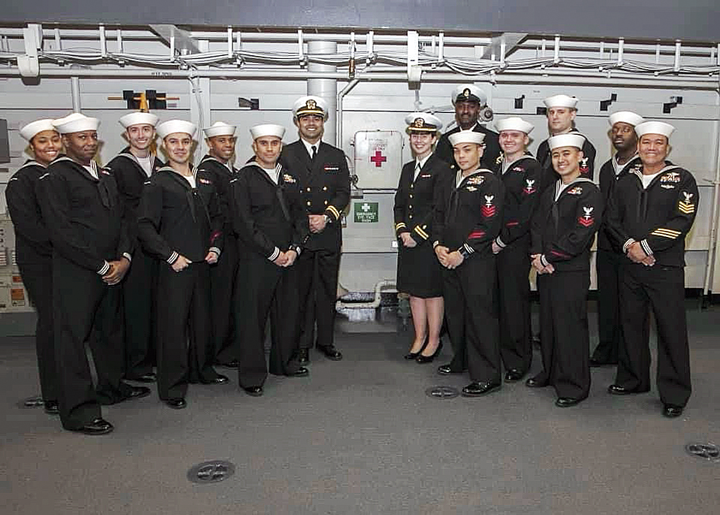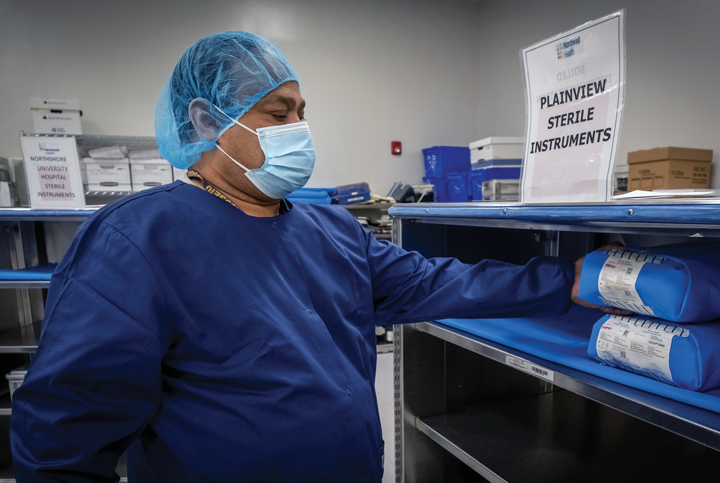- Home
- Article
Four Takeaways on Sterile Processing (and more) From a Military Surgical Tech
By: Matthew Nojiri | Contributing Editor
Published: 4/25/2024
A longtime hospital corpsman compares life in the Navy with the civilian world of ambulatory surgery.
For surgical facilities, the world of sterile processing is a complex web of carefully managed protocols, people, supplies, scheduling and technology. Now, imagine you are on a naval ship, and you are the only staffer on board who knows the ins and outs of your tools — or has any surgical background at all — and it is on you to keep the OR ready for action.
Meet Tyler Tennant, a 13-year hospital corpsman who has learned about the complexity of sterile processing and what it takes to be successful in diverse settings ranging from a large naval vessel, to a small medical hospital “in the middle of nowhere,” to a larger medical center with modern amenities.
Military vs. civilian
The life of a military surgical tech is a unique one, but the principles of discipline and training that apply in the military also relate to care in the civilian world, says Mr.Tennant. “Inherently, we have the discipline aspect (of being in the military), and we have a lot of the training, but I think we have the same issues, which is really interesting,” he says. “There are a lot of parallels with what’s going on outside in the civilian world.”
In an interview with Outpatient Surgery Magazine, Mr. Tennant discussed life as a hospital corpsman and the lessons that can help your facility operate at its best.
Different tech, same principles
For Mr. Tennant, a career as a military surgical tech has meant getting acclimated to work in care settings that all look a little different. In his post, the training is more generalized, but the specialization comes with experience and time.
His work in the Navy has included stints at the Naval Medical Center Portsmouth, the Naval Hospital Guam, the USS San Antonio and the Naval Health Clinic Cherry Point. Portsmouth is a larger medical center with a residency program. The Guam center is a smaller hospital on a small island. The USS San Antonio did not have a surgeon on staff, but it needed to be ready for emergency procedures. As a surgical tech, Mr. Tennant was expected to keep track of the ORs tools and instruments. “It’s a lot of pressure,” he says.
The range of available technology also is wide. Mr. Tennant has worked in facilities that have modern surgical instrument tracking software, as well as others that use pen-and-paper solutions. In each case, staff need to know where to look for guidance. If there isn’t a standard operating procedure for cleaning and tracking, it’s time to take action to create a guide, he says.
“All of this stuff is only as good as you make it,” he notes. “Being in the most different settings, you learn having these policies, updating the policies … and following them is very important.”
The takeaway: In scenarios where your resources, personnel or technology are limited, strong policies and protocols can help bridge the gap.
Grow your culture

Effective sterile processing starts with strong staff, but the workforce is a unique variable. Like most ambulatory surgery facilities, naval bases and ships rely on a roster of caregivers and staff that has some unpredictability from year to year.
In the civilian world, SPDs can build camaraderie as staff grow into their roles over time. In the Navy, however, this is not quite the same reality, as deployments and changing duty stations guarantee turnover from year to year. “It really adds another layer of complexity,” Mr. Tennant says. “It doesn’t matter how efficient we are working together, every few years the entire team is going to change out. I could go to back to Portsmouth and other than the building it would have no resemblance to how it was when I was I there.”
The military also has unique constraints when it comes to recruitment, as potential staff need the requisite military and medical training to serve in OR roles. “It’s the world’s most indirect hiring process,” notes Mr. Tennant.
Beyond staff, leadership also changes fairly frequently, as new commanders move into their roles or to new stations. With each transition, the work in the OR adjusts for new preferences, personalities and needs. “With the military, every time we get new leadership, the entire tone of the operating room really shifts,” he says.
The takeaway: Prioritizing the workforce is essential to support care. Consistency in staffing helps ensure smooth operations, but you need to have contingencies for the inevitable changes in your workforce.
Untangling the supply chain in a world of outside threats

Civilian surgery centers often have several people working in sterile processing, purchasing and supply chain management. In the military, this work can be condensed into a single role, and it’s a big job.
In Naval settings, the task of filling an SPD with necessary supplies — like peel pouches — is complicated by an extra layer of security that limits the vendors you can work with and the technology you can use. “Each facility procures items totally differently. We have all sorts of restrictions (such as not being able to purchase supplies from certain countries),” Mr. Tennant says. “The supply chain can be very complex because the military can be very decentralized.”
Security requirements also limit the systems that be brought onsite. The military is constantly on guard against the threat of foreign adversaries. Investments in decontaminators, sterilizers and other equipment that have become the norm in civilian settings must meet a higher threshold of digital security in the military. Bluetooth and Wi-Fi-enabled systems pose a larger concern. “It could be the coolest system in the world, but if it uses a foreign server, it’s not happening,” he notes. “We don’t have the ability take advantage of the efficiencies that you see in the civilian world.”
This level of security may be above the threshold of a community surgery center, but it also highlights the risks third-party vendors pose in health care. The recent Change Healthcare cyberattack is the most recent example of the ways bad actors are targeting the health and public health sector. The takeaway: The strength of your supply chain requires a thorough, methodical investigation of your vendors, their backgrounds and their potential vulnerabilities.
Fulfilling work
Whether you’re stationed on a Naval base or caring for patients at an ASC, you have committed to work that is fulfilling but all-consuming at times. Intentionally setting time aside to get away from the work is just as important as growing into your role. “Relaxation is an active skill,” notes Mr. Tennant.
Wherever you are, the appeal of working in an SPD, managing a facility supply chain or caring for patients in the OR is universal. “You’re helping someone at their most vulnerable,” Mr. Tennant says. “They are exposed and scared. They are putting blind trust on us.”
The takeaway: There are many challenges working in an SPD or in other roles in surgery, but the payoff of helping others is worth the effort. OSM
.svg?sfvrsn=be606e78_3)
.svg?sfvrsn=56b2f850_5)